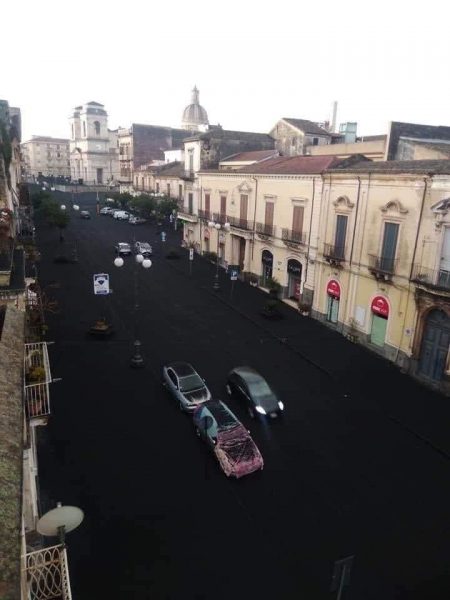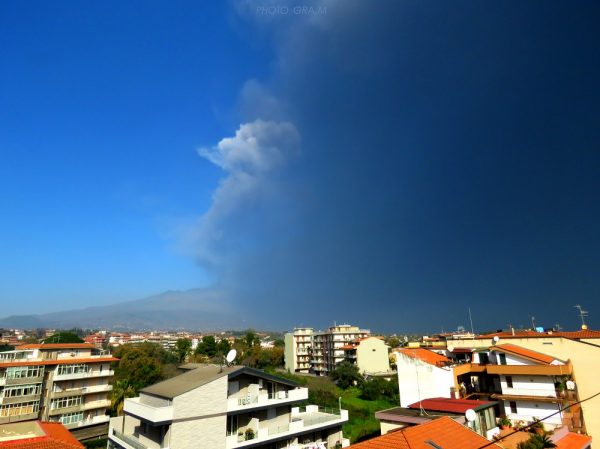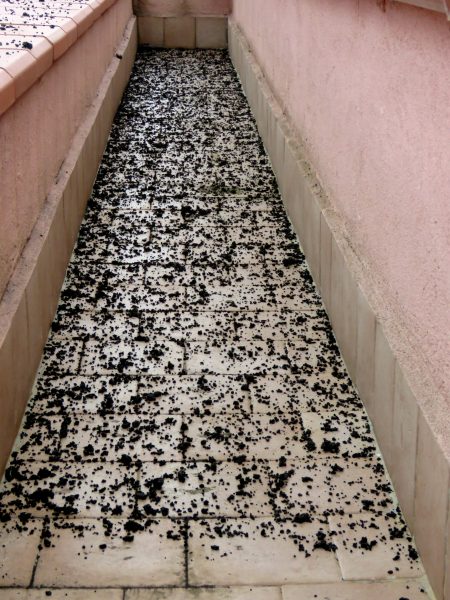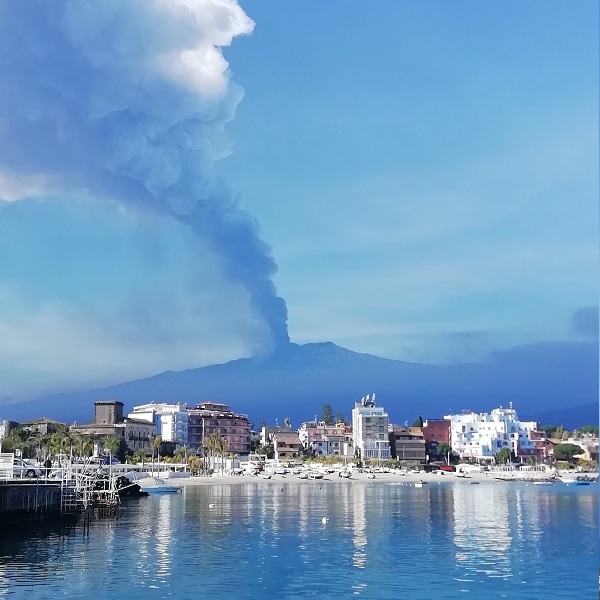UPDATE 15.03.2021
Despite being an always active volcano and always ready to show off its eruptions, Mount Etna now seems to have taken a strange “acceleration”. Restless since 2019, lively in 2020, from January 2021 it began to trigger eruptive episodes with a very particular frequency. First, it was a paroxysm every 24 hours, then the interval became larger. Sometimes it erupts every two or three days, but increases the power of the episodes. People begin to look at the volcano with a new fear. What happens on Etna?
The eruptive phases of Mount Etna
After the 2018 earthquake that somewhat triggered this new lively phase of Etna, the experts of the INGV of Catania held numerous conferences to explain what was changing on the volcano. According to their studies, Etna follows almost cyclic “eruptive phases”, which recur every ten or twenty years. For a decade the volcano erupts from the top, with effusive and all in all calm episodes. Then it begins to erupt explosively, with the lava often looking for alternative routes to the summit craters . After that maybe it goes back to another decade of relative quiet and so on.
For some time there were signs that Mount Etna, after the “quiet” period of 2005-2015, was about to change its register again. Therefore these violent paroxysmal manifestations had long been expected. Perhaps, however, they did not expect them to be so frequent in the span of a few months. And since the lateral rash cannot be ruled out yet, how can you explain the situation to the people without creating panic?
 Paroxysms should not worry
Paroxysms should not worry
Violent and frequent paroxysms should not worry anyway. Because they are an outlet of energy from the summit craters that allows the volcano to expel gas and material. Otherwise, this would cause internal pressure and split the flank even at low altitudes. In short, as long as the summit paroxysms continue, perhaps we are safe from lateral fractures and earthquakes.
Among other things, these paroxysms expel the so-called “primitive magma”. Which is not a bad thing. It only means that the magma remains virtually unchanged from when it is sucked up to when it is ejected from the volcano. A rapidly rising magma does not stagnate, does not seek other ways out and therefore eliminates the danger of low-altitude fractures. At least for now. However, Etna is always unpredictable.
Paroxysms, a spectacle of nature
Between 12 and 15 March 2021, Etna produced the twelfth and thirteenth paroxysms since the beginning of the new phase. Whether they happen during the day or in the night, they are always a fascinating and impressive natural spectacle. The columns of gas and ash, which even reached 12 km in height, were photographed from all over Sicily and Calabria. As well as the very high lava fountains and flows, which arrived and ran aground without problems in the Valle del Bove desert.
Apart from the discomfort caused by the fallout of lapilli and black sand, there are no real dangers for the population. Still there could be damage to agriculture and houses’ gutters. But usually the winds that constantly change in altitude make sure that the problem is “well divided” over the entire area of ??the volcano.
Shall the people worry? Not that much. Just follow the beauty of nature, have a lot of patience and reassure yourself with the press releases and the careful scientific explanations of our good volcanologists . Doctors Stefano Branca, Marco Neri, Boris Behncke – just to name some among so many – are also available on their facebook profiles.
UPDATE 07.03.2021
On the morning of March 7th, 2021, above a cloudy and rainy sky, Mt Etna unleashes the tenth  eruptive paroxysm. It caused a giant cloud of ash and lapilli to fall on Milo, Giarre and Riposto. In the photo alongside (from Gianni Pennisi’s facebook page), the main street of the city of Giarre. From Cathedral square at the bottom to the foreground, it is submerged by an avalanche of black sand and water. This makes it almost impossible for cars to move.
eruptive paroxysm. It caused a giant cloud of ash and lapilli to fall on Milo, Giarre and Riposto. In the photo alongside (from Gianni Pennisi’s facebook page), the main street of the city of Giarre. From Cathedral square at the bottom to the foreground, it is submerged by an avalanche of black sand and water. This makes it almost impossible for cars to move.
The volcano began to show signs of restlessness as early as 3 am. Lava fountains from the South East Crater started with audible roars especially from the north and east. The overcast sky on the eastern side, however, prevented the people from seeing the beginning of yet another paroxysm, the tenth in two weeks. It included very high column of material that headed towards Milo, Giarre, Riposto.
The intense falling of volcanic sand and large lapilli (even 5 centimeters long!) at low altitude surprised people together with the normal, atmospheric rain. Largw black rivers invaded streets, squares and even fields … causing no few problems for local agriculture too.
UPDATE 04.03.2021
The early hours of dawn on March 4, 2021 began with signs of restlessness in the usual South East Crater. They mainly manifest themselves around 7 am with the opening of a new small crater at the base of the SEC cone. From the new crater a small, poorly fed lava flow starts and runs aground almost  immediately. But this is only the prelude to the new paroxysm – the ninth in 15 days! – which is unleashed shortly after, around 9 am.
immediately. But this is only the prelude to the new paroxysm – the ninth in 15 days! – which is unleashed shortly after, around 9 am.
The SEC begins the show of very high lava fountains, with copious emission of ash that again creates a huge plume directed towards the sea. In the meantime, the fracture that now characterizes this crater begins to emit rivers of lava that overwhelm the newly born cone and pour deeply towards Valle del Bove.
The paroxysm begins to run out only after 10:30 and as soon as it calms down the volcanologists will go to check what remains – if any – of this new small hole at the base of the South East. And if the future eruptions of this complicated crater will be, from now on, “choral” or still a single solo song.
UPDATE 02.03.2021
It happens at around noon on March 2nd, yet another surprise from Mount Etna.
A rapid rise in the tremor, the announcement live by the INGV and shortly thereafter the South East Crater was again the protagonist of a paroxysm – the eighth – once again of considerable power. Lava fountains pushed to great heights, while a plume of gas and ash rose above the Sicilian coast for miles.
Sandy fallout to the south
The winds pushed the volcanic material first towards Acireale, then suddenly to the south, with black sand falling on Mascalucia, Paternò, Misterbianco, Nicolosi and Catania. As always, the paroxysmal activity ended in two hours, without serious damage. Too bad for the clouds caused by the humid climate of these days that have covered Mount Etna, preventing many from seeing yet another great show!
By now the volcano’s rhythm seems to have stabilized at a paroxysm every 30-40 hours, although lately the time interval has lengthened. Although they cannot predict the duration of these phenomena over time, volcanologists are sure that Etna will offer many more. It is part of the “eruptive phase” in which the volcano has entered for a couple of years now and which will reserve many surprises.
UPDATE 27.02.2021
After a week of fire and lava, explosions and violent tremors, Mount Etna hasn’t expressed anything for 48 hours.
A silence that amazes and leaves the many “fans” waiting with cell phones in hand, but it does not upset the INGV volcanologists that much. There is a break, perhaps even a long one. It could be weeks, maybe months. But the volcano can hardly be considered “quiet”.
These cyclical phases, which are repeated at well-defined periods, also give these long pauses but the paroxysms are always ready to resume, in a not too distant future. So let’s say that at the moment the eruption seems to have subsided but we don’t know how it can evolve in the next few days (or in the next 24 hours?).
IT DEFINITELY WAS A VERY SHORT BREAK!
NEW UPDATE, ONLY 10 HOURS LATER.
A powerful paroxysm started from the South East Crater around 9 am on February 28, 2021, a few hours after the INGV announcement that the eruption had “subsided” for the moment.
But Etna always takes you by surprise and this time it really left everyone speechless. A huge cloud of slag, lapilli and ash has enveloped the eastern flank of the volcano causing heavy repercussions on the villages of Zafferana, Milo, Giarre, Mascali, Riposto.
The sky was totally dark like in a real storm. The eruptive phenomenon also this time had a short but intense duration, less than two hours.

UPDATE 24.02.2021


UPDATE 23.02.2021
 Mount Etna Eruption 2021
Mount Etna Eruption 2021
Without brakes, but with a now constant pace, Mount Etna continues its daily eruptions. In the late evening of today, Monday 22 February 2021, the volcano thunders again in the dark. The INGV press release brings the time of 22:56 when it informs everyone that:
“there is an increase in frequency and intensity of Strombolian activity at the South East Crater, with the launch of products abundantly outside the crater rim. From about 21:10 UTC the average amplitude of the volcanic tremor shows a sudden further increase. At present the amplitude is within the high level.
The source of the tremor shows a gradual shift towards the SE Crater, at a depth of 2500 m above sea level. Infrasonic activity is significantly increased with a high rate of occurrence of infrasonic transients. These are located in correspondence with the SE Crater ”
Primitive magma
During the day yesterday, the rumor spread through the News that the magma erupted by the volcano was “rare, primitive type”. Volcanologists have patiently explained that the term “primitive” is purely scientific . It indicates, on the contrary, a new and lively magma. This could give such eruptive spectacles for a long time to come. However, there is nothing so “rare”. Similar paroxysms, and with equal frequency, are not new to Etna: it has manifested them dozens of times in the past. Just recall the continuing crises of 2000 and the most recent of 2013.
UPDATE 21.02.2021
A 4-hole paroxysm
The tremor rose already in the morning of February 20th but reached its maximum peak at around 10 pm. The lava fountains started about an hour later, increasing in intensity and height over the course of the night. A very powerful and particularly spectacular one was recorded at around 2:15 am , with an estimated height of almost a kilometer!
course of the night. A very powerful and particularly spectacular one was recorded at around 2:15 am , with an estimated height of almost a kilometer!
Spectacular and impressive is the vision of four eruptive holes all located inside the main crater South East, which made the eruption truly look as a “choral concert”. This time too, there was a significant fallout of ash and lapilli which, however, mostly affected the western towns.
What leaves you speechless, in addition to the spectacularity of these paroxysms, is also the almost Swiss punctuality with which they occur. Many speak of the “30-hour rule”, as if the volcano knew it had to erupt within those set time intervals. And in fact … that’s what it does! At the Institute, work never stops, many volcanologists have not been resting for days. Because Etna always takes you by surprise. And even if now it seems to have finished… tomorrow is a whole new story to rewrite.
UPDATE 19.02.2021
Etna gives no respite, and does not seem to have any itself. At 9 am on February 19, the volcano becomes restless to the point that the Institute of Volcanology immediately goes into alert. The signals are initially almost harmless … a few snorts, dancing tremors. Then everything suddenly increases, as is now “tradition”. At around 10.15 the explosions at high altitude – the South East Crater always protagonist – become powerful and a gigantic ash and lapilli mushroom-shaped cloud begins to rise.
 the new explosion seen from Naxos Bay
the new explosion seen from Naxos Bay
Behind it the lava fountains are very high and accompanied by continuous roars (video here) that really sound like the roar of a dragon! Immediately afterwards the lava streams come out, the longest of which descends on the north-east side. Like the previous ones it runs aground in Valle del Bove after having traveled several meters in steep slope.
In recent days, between one paroxysm and another, the volcanic tremor curve has followed an anomalous trend. Oscillations worthy of a seismograph do not let us understand the “intentions” of Etna. However, the monitoring work of volcanologists continues incessantly and extremely efficient. The updates will continue to check how the situation evolves, which at the moment does not seem destined to calm down yet.
We remember that Etna is always active and lively, but that in the last two years it has manifested a radical change that is expressed with these surprising and fascinating eruptive phenomena. Currently, three major paroxysms have occurred in a week, a completely new style that ignites the interest and passion of professionals … and not.
UPDATE 18.02.2021
It was a night of fire! Yet yesterday it all seemed to be over. “She is giving us only a break” …. the volcanologists of Catania had said, however, describing the apparent state of calm of “Mamma Etna”, after an amazing and powerful eruption. Indeed, a paroxysm, as it is called scientifically. In the afternoon of February 16th, in fact, the volcano had emitted very high columns of ash and two long lava streams that had poured into the Valle del Bove. The phenomenon had lasted a few hours, from 4 to 6 pm and in the evening the lava even seemed to have died out.
 lava pouring in Valle del Bove
lava pouring in Valle del Bove
A new phase in the night
On the following 17th February the volcano did not show particular signs , except for some isolated explosion always from the South East crater – the absolute protagonist of these events. But if the people, still sweeping ash and lapilli, believed that peace had returned, the sceintists of the Institute of Volcanology of Catania spoke of a “pause”.
Etna still had so much to say. And it demonstrated it in the night between 17th and 18th February, precisely between midnight and 3 am. Increased tremor, violent explosions with lava fountains that reached 700 meters height and two large streams of incandescent lava. The largest headed south-east, entering the Valle del Bove as usual. The other, a smaller one, instead headed south-west, stranded in a flat area at the foot of the Sella Crater.
UPDATE 16.02.2021
Etna, the long time expected great eruption started
The great eruption of Mount Etna, which had been expected for over a year, began at 4 pm on February 16th, 2021. First, a small lava overflow from the South East crater (SEC) and a significant increase in tremor. Then, in just less than two hours, alert levels have risen. At about 5:10 pm, very violent explosions made the slopes of the volcano and the foothills vibrate.
Shortly after, columns of smoke, steam and ash rose from the SEC-NSEC complex. At the same time a large amount of material collapsed down, towards Valle del Bove. From the fractures opened with the explosions, several lava streams came out in a few seconds. Two of the largest immediately reached the bottom of the valley that opens onto the eastern flank of Etna.
UPDATE 09.02.2021
The strange eruption that has been characterizing Mount Etna’s activity for one year and three months continues uninterruptedly. By now the population has got used to that flaming eye that gushes far away every evening, with increasing energy. The protagonist is almost always the South East Crater , but in fact all the summit craters are in full swing. New South East, North East, Voragine, Bocca Nuova… the magma fills all the ducts. Etna is literally as full as an egg!
A twelve-holes eruption
The news, as Dr. Behncke of the National Institute of Geophysics and Volcanology of Catania reveals to us, is that behind the visible spectacle there is another one we cannot see. But the instruments, the thermal cameras and the secret eyes of volcanologists do see it. Inside each crater, new small craters are forming. Cones stand up where previously there were isolated holes. The Sella Crater, formed between the South East and the New South East craters -and collapsed last month- is creating yet another cone.
 photo by G.Musumeci
photo by G.Musumeci
“The vents active at this moment inside the summit craters are no less than twelve” says Boris Behncke, on duty at the INGV and watching this wonderful show “each hole gradually transforms into a new crater and in the meantime more holes will open “. A truly unique phenomenon that, as the volcanologist himself says, “I had never seen before, in my thirty-year career!”
A global eruptive activity
The strange thing is not the continuous opening of many small mouths, but the fact that these are in activity at the same time. And not only that. In addition to them, all the summit craters are active at the same time. A fury that is unusual even for a super active volcano like Mount Etna. It looks as if the mountain is trying to change its face and is in a hurry to do so, too.
This eruption is certainly new, and it is yet another surprise that Etna reserves for its inhabitants and for those who study it for a profession. In fact, scientists have long been waiting for a lateral eruption which, according to the signals, promises to be a possible event. The volcano on the other hand is full “to the brim”. Yet once again it upsets plans and forecasts and creates something different. Unexpected. All you can do is keep monitoring and enjoying the show. And keep hoping that the “final surprise” is not too dangerous.
(the photo above the title is by Maria Liotta)